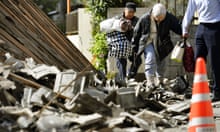A second major earthquake in less than two days has shaken Japan’s southern island of Kyushu, with at least 34 people thought to have been killed, about 1,500 injured and more feared buried after building collapses and landslides.
The 7.3 magnitude earthquake struck at about 1.30am on Saturday, waking people across the island – including the thousands already in crisis centres. It caused widespread damage, with several landslides and a village evacuated over fears a dam might burst.
On Thursday a magnitude 6.5 earthquake in the same region of Kumamoto brought down buildings, killed nine people and injured about 800. More than 100 aftershocks followed until the bigger quake on Saturday morning, which led to the earlier, smaller event being reclassified as a foreshock.
Japan’s prime minister, Shinzō Abe, expressed concern about secondary disasters from mudslides as the weather forecast for the area predicted wet weather and strong winds.
Rain began falling at about 3pm local time, with torrential downpours anticipated through the night. The Fukuoka Meteorological Agency estimated that between 100mm and 150mm of rain would fall on Kumamoto over the next 24 hours, increasing the risk of landslides.
“Daytime today is the big test” for rescue efforts, Abe said. He called off a visit to Kumamoto on Saturday after the new earthquakes struck. “He was scheduled to visit Mashiki but now he does not think that would be the best use of his time,” his office said.
Before the rain began, 4,200 households in the mountain town of Misato were told to evacuate, along with 40 in the village of Nishihara and 5,200 in Oita prefecture’s city of Yufu, which also suffered damage in the earthquake. More than 15,000 people have been affected by the orders.
The Japanese government’s chief cabinet secretary, Yoshihide Suga, said on Saturday that 1,500 people had been injured, 80 of them seriously, and that casualty figures were likely to increase. Nearly 70,000 people had left their homes, he said.
He said the military presence would be boosted to 20,000 for rescue efforts. Police and firefighters are also being ordered to the region.
In a nationally televised news conference, Suga asked people not to panic. “Please let’s help each other and stay calm,” he said.Saturday’s quake triggered tsunami warnings, though none took place, and there was confusion and anxiety for the thousands of evacuees whose homes had already been destroyed or damaged.
One major landslide tore open a mountainside in Minamiaso village in Kumamoto prefecture, destroying a key bridge that could cut off food and other relief transport to the worst-hit area.
Another landslide hit a road, collapsing a house that fell down a ravine. In another part of the village, houses were left hanging precariously at the edge of a huge hole.
The earthquakes’ epicentres were relatively close to the surface, at a depth of about six miles, resulting in more severe shaking and damage. The public broadcaster NHK TV said as many as eight tremors an hour were being felt in the area.
At a news conference on Saturday, Abe told reporters he wanted the government at all levels to share information in a timely manner.
The government planned to send 5,500 police officers, and members of the fire service would be sent to the prefecture. “Securing the safety of citizens is our top priority,” the prime minister told media.
On Saturday the latest destruction and aftershocks left Kyushu on tenterhooks. NHK TV showed people in evacuation centres in shock and unable to sleep.
“The earthquake last night was much worse than the one on Thursday,” said Yumiko Ogata at the Mashiki gymnastics centre, one of the evacuation stations. “People are holding up psychologically, but nobody slept last night.
“We need food and we need water. We may just about get through, lunch but we do not have anything for this evening.”
The situation worsened at the centre as the day went on. Food did not arrive and supplies were short. “We have no idea whether or not supplies are on the way. As well as food and water, the rain is coming in and the temperature is going to drop. We need blankets now too,” Ogata said.
In the Kumamoto village of Aso a highway bridge was swept away by a landslide and about 200 people were evacuated from the village of Nishimura after reports that the Okirihata dam was under structural strain. The Uto city hall also partially collapsed and about 150 patients had to be transferred from Kumamoto city hospital after the building’s ceiling came down. “We can no longer care for people here,” a hospital official told the Sankei newspaper.
NHK TV showed stones that had tumbled from the walls of the historic Kumamoto Castle and a smashed wooden structures in the complex. At the Ark hotel, east of the castle, hotel guests woke up to strong shaking and a warning siren. Hotel staff told guests, including tourists and journalists covering the quake, to evacuate their rooms and gather in the lobby for safety.
A bright spot, broadcast repeatedly on television on Friday, was the rescue of an apparently uninjured baby, wrapped in a blanket and carried out of the rubble of a home.
Kyushu Electric Power Co, the utility operating the island’s Sendai and Genkai nuclear power plants, said its reactors were unaffected. In Kumamoto, however, 100,000 homes were without power.
Yukinori Hori, an official at the Sanrigi residents centre, said the more than 300 local people taking shelter there had enough to eat and drink and were stoic in the face of the disaster. “We have a lot of problems that we are not thinking about, because they are small and at least we have supplies and our lives.”
Associated Press contributed to this report



